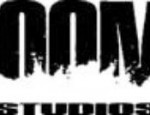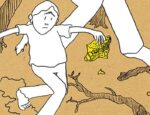A poignant commentary on perception and belief driven by characters whose world is literally being washed away, Strange Fruit #1 is a thought-provoking mix of social history and fantasy.
 Mark Waid is known for building worlds in his comics that are equal characters in his stories, and such is certainly the case with his latest creation, Strange Fruit. This four-issue series is set against the backdrop of the Great Mississippi Flood of 1927, in the fictitious deep-south town of Chatterlee, Mississippi.
Mark Waid is known for building worlds in his comics that are equal characters in his stories, and such is certainly the case with his latest creation, Strange Fruit. This four-issue series is set against the backdrop of the Great Mississippi Flood of 1927, in the fictitious deep-south town of Chatterlee, Mississippi.
The rising river is threatening to overrun the levee, and the story begins by establishing the town’s overt racial inequalities as a group of white men go to a “colored café” to round up black workers and return them to sandbagging the levee. While there, they encounter Sonny, an accused thief who runs and avoids capture.
Meanwhile, a black engineer from Washington is explaining to white town officials – without much success – that the town will be washed away soon and recommends that they move efforts from sandbagging the levee to digging a relief channel to the east.
 Adding a supernatural element to the story is the object that streaks across the sky before crashing into a portion of the levee. Near the end of the book, its naked occupant runs into Sonny just as white-robed members of the KKK are about to overtake the fleeing thief.
Adding a supernatural element to the story is the object that streaks across the sky before crashing into a portion of the levee. Near the end of the book, its naked occupant runs into Sonny just as white-robed members of the KKK are about to overtake the fleeing thief.
Perception and belief are devices Waid and Jones use to propel this story, and they converge when we meet the mysterious stranger. The KKK members simply see two black men, and they instantly decide to hang both from the nearest tree. However, the stranger bests them easily and saves the completely shocked Sonny.
Waid doesn’t sugar-coat racial tensions, socio-economic status, or the prevailing attitudes of the time. An interesting scene with the KKK members and a local senator uncovers the tensions among the town’s white residents regarding the poor treatment of black workers, prompting the senator to say, “You ignorant assholes. You know why no one ’round here’s barely got two nickels to rub together? You keep drivin’ the coloreds away, we ain’t got no labor force. We ain’t got no labor force, we ain’t got nothin’ t’ sell and no pot t’ piss in!”
 JG Jones painted the panels with a painstaking attention to period detail that sets the tone for the story. (And while I appreciate his obvious affection for vehicles, Jones’s depictions of the pick-up trucks appear to be based on Model A Fords, which didn’t debut until 1928. Model T Fords would have been the correct derivative subjects for this piece set in 1927.)
JG Jones painted the panels with a painstaking attention to period detail that sets the tone for the story. (And while I appreciate his obvious affection for vehicles, Jones’s depictions of the pick-up trucks appear to be based on Model A Fords, which didn’t debut until 1928. Model T Fords would have been the correct derivative subjects for this piece set in 1927.)
His attention to detail in facial expressions drives home the urgency of every character’s situation, from the engineer’s frustration to the senator’s anger. Layers of tension within each scene are brought to life by Jones’ almost demure color palette, adding to the underlying symbolism that more is going on here than the stark contrasts of black and white.
Is the town’s newest arrival a threat or a beacon of hope? Perception and belief will probably drive that answer. The river is literally washing away the town, and this cleansing of biblical proportions is likely to usher in a whole new way of life in Chatterlee.
Mark Waid (W), J.G. Jones (A) • BOOM! Studios, $3.99















